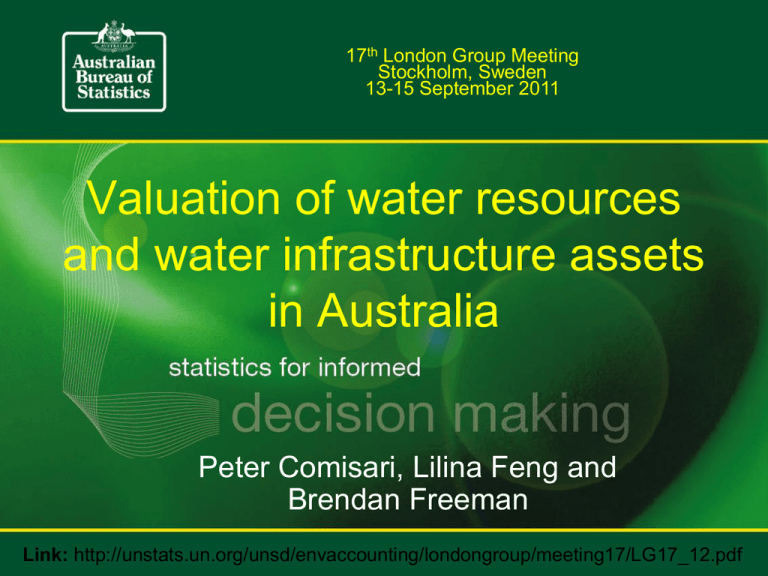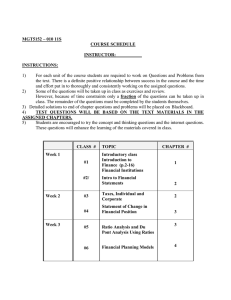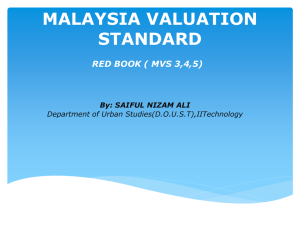Integrated Environmental-Economic Accounting in Australia
advertisement

17th London Group Meeting Stockholm, Sweden 13-15 September 2011 Valuation of water resources and water infrastructure assets in Australia Peter Comisari, Lilina Feng and Brendan Freeman Link: http://unstats.un.org/unsd/envaccounting/londongroup/meeting17/LG17_12.pdf Session overview • Background • Water resource valuation study • Valuing water infrastructure • Appropriate water infrastructure valuation methods • What the International Statistical Standards say • Recommendations Background • Both the 2008 SNA and SEEA-2003 recommend monetary valuation of water resource stocks, but provide only limited insight as to how this could be achieved. • Why value water resources? • Water has several special characteristics – Trading is only possible where gravity supports bulk movement – Water is an essential product – Water exhibits public good characteristics • Australia’s water supply business has unique characteristics – Water prices are tightly controlled by state and territory governments (IPART, ESC, ERA etc…) – Australia’s urban water stocks are large by international standards Study: The value of water resource stocks for selected entities • A total of 13 water suppliers were profiled – five urban, eight rural, and two hydro-electricity suppliers • Valuations for the water resources owned by the selected firms were attempted using a methodology based on NPV of expected resource rents • Gross Operating Surplus (GOS) was used as a starting point from which to calculate resource rents • Hydro-electricity suppliers were included in the review as a point of comparison Results – Urban Suppliers • Negative resource rents are indicated with the ‘-’ sign Results – Rural suppliers • Negative resource rents are indicated with the ‘-’ sign Findings • Negative resource rents were generated for the majority of water suppliers. • Average Rates of return (RoR) on produced capital for water suppliers was comparatively low to the market; Urban – 4.6%, Rural – 1.3% • Net operating surpluses for many water suppliers were low relative to the value of the water infrastructure assets used in the production process • Average RoR on produced capital for Hydro-Electricity firms was considerably higher at 15% – Higher RoR likely due to the greater degree of autonomy hydroelectricity firms have in setting the prices they charge Issue: valuing water infrastructure • Determining the most appropriate valuation basis for water infrastructure assets is critical to the process of valuing water resource stocks. • The choice of valuation approach can result in significantly different valuation figures for the same assets • The SEEA-2003 and SEEA Water provide no direct guidance on the question of water infrastructure asset valuation • The ABS is committed to publishing annual water accounts and the inclusion of values for Australia’s water infrastructure assets has been proposed Why value water infrastructure (WI) assets? • Measure the net worth of a water producing business • Establish a sale price for WI-Assets • Determine a replacement cost for WI-Assets • Generate estimates for returns on WI-Assets • A basis for generating ongoing measures of productivity How to value water infrastructure assets • ‘Fair value’ (revaluation) preferred to ‘Historical Cost’ – Reflects the true economic worth of the asset • Fair value defined by the Australian Accounting Standards Board “The amount for which an asset could be exchanged, or a liability settled, between knowledgeable, willing parties in an arm’s length transaction.” (AASB 1 First-time adoption of the Australian Accounting Standards, para.23) “If there is no market-based evidence of fair value because of the specialised nature of the item of property, plant and equipment and the item is rarely sold, except as part of a continuing business, an entity may need to estimate fair value using an income or a depreciated replacement cost approach.” (AASB 116 Property, Plant and Equipment, para. 33) Viable fair value valuation bases • Observed Market valuation (OMV) Value is determined using market based evidence • Net present value (NPV) The present value of future cash flows expected to be derived from an asset or cash-generating unit • Depreciated replacement cost (DRC) The current replacement cost (cost to construct an asset that performs the same functions today) net of accumulated depreciation Functionality of each basis • Market valuation (OMV) The highly specialised nature of water infrastructure assets means a market price is unlikely to exist • Net present value (NPV) Preferable if the future economic benefits (commercial return) of the asset are primarily dependent on its ability to generate a net positive cash inflow • Depreciated replacement cost (DRC) Preferable if the benefits expected from holding the asset are not reflected in the income stream of the water supplier International statistical standards and the valuation of fixed capital • SEEA-2003 and SEEA Water Provide no direct guidance as to the appropriate method of valuing water infrastructure assets • 2008 SNA In the absence of an OMV, an asset valuation equivalent to the DRC is recommended • IMF – Government Finance Statistics Manual (2001) Provides clear support for a valuation based on DRC, in the absence of observable market prices • ASNA Uses the Perpetual Inventory Method (PIM). The principles and techniques contained in the PIM are consistent with the DRC method Observations made of the water supply business in Australia • Water suppliers operate under a regulatory regime, which aims to ensure low water prices • As such, much of the benefits of using the WI-Assets are not reflected in the expected future income streams of water suppliers – Many of the economic benefits of WI-Assets in fact reside in their ability to provide a cheap, safe & reliable water supply • Businesses in the water industry, therefore, usually generate minimal or no profit – although they view themselves as for-profit Recommendations • It is recommended that water infrastructure assets be valued on the basis of DRC • The DRC Method provides a meaningful basis for deriving estimates of the full return on investment in WI • Adoption of the DRC method is entirely consistent with the principles underpinning the preferred valuation basis of the SNA 2008 and, therefore, Australia’s official economic statistics • DRC is also consistent with the methods set out in the SEEA-2003. Therefore, it provides the preferred basis to value WI-Assets with the ABS water Account Contact details: Peter Comisari: Lilina Feng: Brendan Freeman: peter.comisari@abs.gov.au lilina.feng@abs.gov.au brendan.freeman@abs.gov.au








